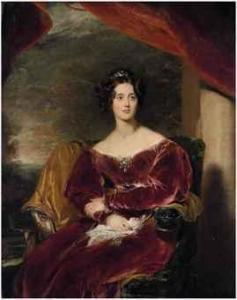 |
| Copyright – The Philadelphia Museum of Art |
In February of 2012, “The Look Of Love,” an exhibition dedicated to the art of Georgian-era eye miniatures, will take place at Alabama’s Birmingham Museum of Art, curated by Graham C. Boettcher. It will feature the collection of Birmingham residents Nan and David Skier; theirs is perhaps one of the largest collections of this art-cum-jewelry in the world, at some 70 pieces.
I am one of the contributors to the exhibition catalog, though I own but one lover’s eye. Mine is a man’s eye surrounded by seed pearls and set in a gold ring. This ring is shown on page 165 of my biography of Grace Dalrymple Elliott, My Lady Scandalous (Simon and Schuster, 2005). I do not know who the man was, nor do I know the name of the artist. I also do not know for whom it was intended, but I believe it was a mourning ring.
 |
| Copyright – The Ornamentalist |
The great majority of eye miniatures fall into this category of nameless subject/nameless artist/unknown owner. Moreover, not much has been written on this hybrid form of painting/jewelry, nor are there significant sources for research into this topic to fill in the gaps. What has been written tends to repeat the same historical anecdotes but does not provide much in the way of new material. This 2012 exhibit promises to change this situation. The three essays I have read recently quote exactly the same material; it is way past time to break new ground!
Portrait miniatures abounded in the time of the English Georges in the 18th century/early 19th century, eye miniatures did not. These miniscule paintings very carefully delineated one eye, one eyebrow, perhaps a some wispy strands of hair falling to one side [one of the ways to differentiate between men and women), but never a nose. It was, to put it romantically, an eye – usually the eye of a lover –floating untethered in space, gazing unabashedly at the beloved.
These miniatures were not meant to be seen by just anyone. Their nature was secret, more clandestine, as it were, not at all public. They were meant to be love tokens exchanged by a pair of lovers…and theirs alone. The owner of the eye miniature could carry it safely, knowing that only those with whom she/he chose to share her/his innermost secrets would know whose eye it was.
Those that were not tokens of a lover’s affection – and there are a fair number of these — fall into the category of sentimental or mourning jewelry and are identified by a single diamond tear falling from the eye, or a surround of seed pearls, pearls being another metaphor for tears or mourning. (Sometimes a tiny lock of hair was placed behind the painting, reminding one of those strange pieces of hair jewelry favored by the Victorians.)
 |
| Copyright The Art of Mourning |
The eye miniatures were usually painted in watercolor on ivory, vellum, or even waxed playing card, and protected by a glass cover. Average size was barely half an inch across. The eyes not surrounded by pearls were often framed in garnets, amethysts, and other popular gemstones of the period. It has been estimated that only one to two thousand of these pieces were ever made, making them very rare and thus very collectible.
 |
| Copyright The V and A Museum |
The tear(s) are easier to see here, and, of course, the seed pearls emphasize this is a bereavement brooch.
































